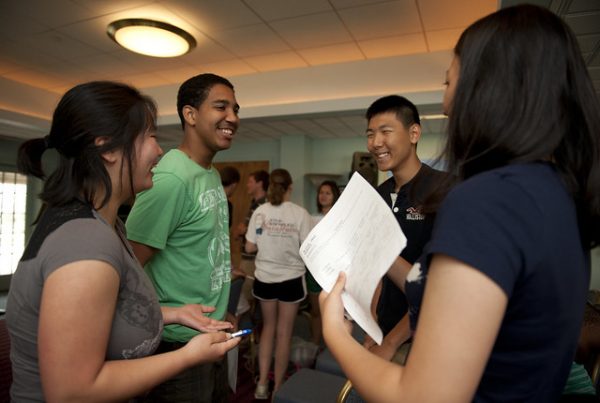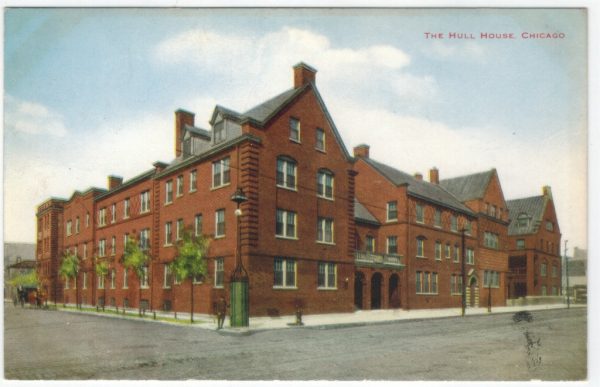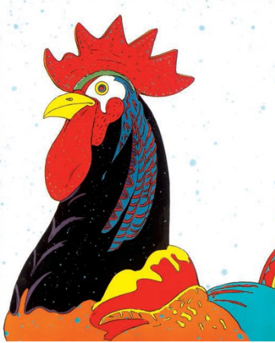As a sociology instructor, I have been thinking about how ice breakers can be used for students to get to know each other and to seamlessly move into course content. There are a lot of good ideas for ice breakers online, including some that do a great job of building community in the classroom. However, I find myself moving away from them because they seem to be a one-trick pony.
Here are three examples of ice breakers that could be used to connect students with each other, as well as slide right into sociological content.
The Machine by Viola Spolin of Hull-House
Hull-House educators, Viola Spolin and Neva Boyd, used improvisation and theater games to help their students, who were often immigrants, become “fuller participants in democratic society.” The games created new ways to for immigrants to connect with each other, even if they had different cultures and backgrounds.
One of Viola Spolin’s activities was to have a team of people create a “machine.” Each person in the activity is a single “part” of the machine. It starts with one person making any motion and accompanying sound. It must be something that they can repeat over a few minutes. Then someone else adds another part to the machine, specifically, a motion and sound that works in reaction to the first motion and sound. Then someone else adds in another part and then another. The machine can speed up or slow down, adding a level of silliness.
With the right class, this would be a great way to break the ice during the beginning of class. In addition to being fun, this activity can be used to introduce a variety of topics. For instance, I might use this at the start of a Juvenile Delinquency class as a way to introduce the history of the juvenile justice system. Jane Addams and the entire Progressive Era are important because they reacted to the brutality found in the Houses of Refuge — all covered in my Juvenile Delinquency course. This activity could also be used in social work classes to introduce Jane Addams and various perspectives on helping people, or in a Methods class that uses the “Maps and Papers Nationality Map” to talk about early scholarly studies. Lastly, you could use this activity in an Introduction to Sociology course to illustrate the interconnectedness of society and its institutions.
Deviant Behavior Notecards
In this activity, I write down ten different deviant and criminal behaviors that range in seriousness from leaving a dog in a closed car to physical assault to using someone else’s Netflix account when you aren’t paying for it. Depending on the size of the class, I divide the students into small groups of three to six and give each group the same set of ten cards and ask them to place them in order from most to least serious. All group members must agree on the order. It gets the groups talking, and they always laugh about certain behaviors and how they think that they aren’t serious even though they know that they are.
After they have organized their list, I ask the students to identify three themes that they used to organize the list. Usually, they include things like the punishment that would come with the behavior, the harm done to the possible victim, and the moral consequences of the behavior. This leads me into a discussion about the social construction of deviance and how we determine what is deviant and what is criminal. I also use this as a way to teach students about the difference between deviance and criminality. You could use this second activity after the first, or on its own. In small groups, students separate the behaviors into a Venn diagram with sections for criminal behaviors, deviant behaviors, and then behaviors that are both. This activity could also be used in a Juvenile Delinquency, Criminology, or Deviance course.
Zoom Puzzles
This activity draws on children’s books called Zoom and Re-Zoom. These books have also been used as a form of team building by Launch Leadership and Andrea Johnson. In order to prepare for this ice breaker, you need to create the sequential pieces based off of the children’s books. Each piece should include one image. The next piece then consists of the previous image within another image. You can see an example with the roosters from the book below. You could also create your own Zoom puzzle. Once your puzzle is created, depending on your class size, you could split the class into small groups of four to six people. Give each group the same puzzle and simply ask them to solve the puzzle. They will need to piece together the story from the puzzle pieces.
At first, students look at the pieces and think that it’s a jigsaw puzzle so they start to move the pieces around. Eventually, someone notices that there is a similar image in multiple puzzle pieces. For example, as seen above, in Zoom, there is a rooster that shows up on numerous puzzle pieces from different vantage points. At that point, they start to realize that it is the same scene across all of the pieces; it is just further and further zoomed in. In order to complete the activity, students have to arrange the images from the farthest out to the closest in.
This is a fun activity for students because it gets them out of their seats and because there is something tangible for them to move around on their desks. They talk with each other and laugh once they realize how to solve the puzzle. This activity could be used in an Introduction to Sociology course to introduce the Sociological Imagination and the idea that students need to “zoom out” and look at the structural influences on their lives and behaviors. Personally, I would use this in a Juvenile Delinquency class to talk about the differences between macro- and micro-level theories. This would help students understand the differences in theories of crime and what these theories focus on as reasons for criminal behavior. I think it would work in a similar way in a sociological theory course.
—
We, as sociology instructors, often rely on ice breakers as a way to lay the foundation for active learning or future discussions, and I think that we could make them even more useful. I hope that one of these ideas may be helpful for you, not only to help students connect, but to help you to move directly into course content too.
Dr. Andrea Krieg is an Assistant Professor of Criminal Justice at Elmhurst College. She earned her PhD from Bowling Green State University in Sociology. She teaches a variety of courses and loves her time in the classroom.




